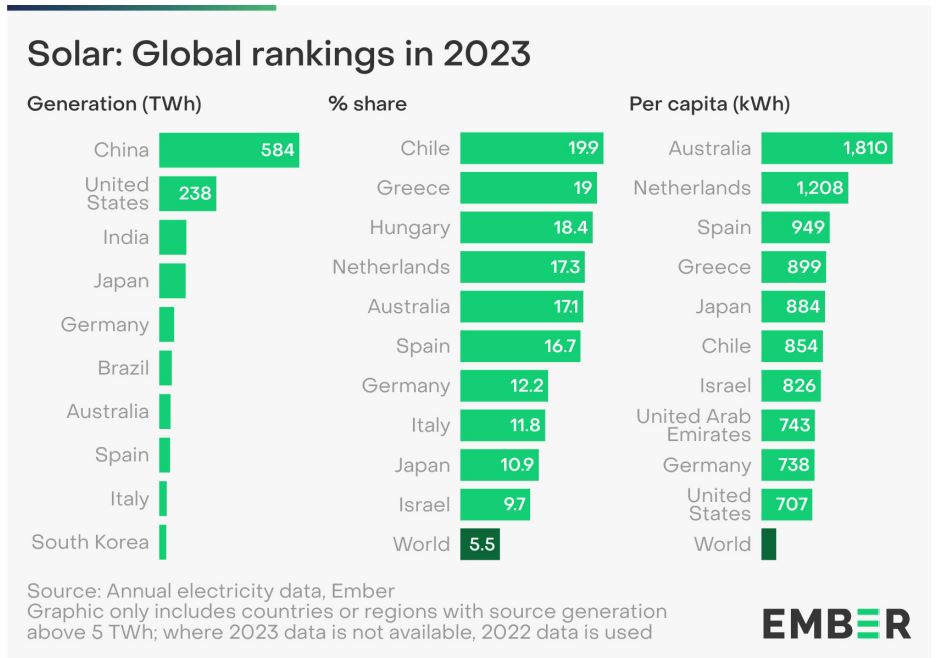Solar energy emerges as the leader of Renewable Energy Sources (RENs), as the expansion and development of photovoltaics has resulted in 33 countries producing through them more than one tenth of their electricity. Greece had the second highest share of photovoltaic power generation in the electricity mix (19%), followed by Hungary (18%) and the Netherlands (17%). Chile was in the first place, with almost 20% in 2023. According to Ember’s clean energy think tank analysis, photovoltaic and wind power generation will form the backbone of the future electricity system, providing almost 70% of the world’s electricity by 2050.

Photovoltaic and wind power plants contributed 13.4% of electricity generated internationally, and the remaining percentage of “clean” energy came from other renewable sources, hydropower plants. On a per capita basis, Australia produced the most electricity from solar energy with 1,810 kWh, while the Netherlands came second with 1,208 kWh. Spain became the third largest producer of solar energy per capita in 2023, having ranked fifth in 2022. The think tank also makes a special mention of China’s sovereignty. This country produced the most electricity from solar energy (584 TWh), even surpassing the United States (238 TWh). India surpassed Japan and became the third largest solar generator by 2023 (113 TWh). This classification does not include countries with less than 5 TWh of solar production.
The EU produces 44% of its electricity from renewable energy
The European Union is steadily moving upwards by generating 44% of its electricity from renewable energy, with the bloc contributing 17% of global growth by 2023. It is noted that more than half of the increase in electricity demand in 2023 came from five technologies: electric vehicles (EVs), heat pumps, electrolytes, air conditioning and data centers. The spread of these technologies will accelerate the increase in demand for electricity, but the overall demand for energy will decrease, as electrification is much more efficient than fossil fuels. Solar was the world’s leading electricity supplier last year, providing twice as much new energy as coal. Itined its status as the fastest growing energy source for the 19th consecutive year.
Ember expects the increase in clean energy to outweigh the overall increase in electricity demand, leading fossil-fuel energy production to drop by 2% by 2024. More than half of the economies are already at least five years from peak fossil-fuel electricity production. Emissions from these 118 electricity sectors have decreased by a quarter in the last decade. In total, they account for 43% of global electricity demand. Fossil fuel production in the UK has declined by 63% since its peak in 2008, in Greece by 57% (having peaked in 2007), in Spain by 59% (2005) and in Germany by 42% (2007). This decline is linked to the high infiltration of LPGs. Other major developed economies have peaked and have seen smaller falls. Fossil fuel production in the US decreased by 16% since its peak in 2007, Canada by 26% (has peaked in 2001), Australia by 24% (2009), Japan by 29% (2012) and South Korea by 13% (2018). Overall, OECD countries saw electricity sector emissions peak in 2007, down 28% since then. Reducing emissions in the electricity sector is already a reality for many countries and the scenario is now ready for global emissions to begin to decrease.
Renewable energy for the first time accounted for 30% of global electricity production in 2023, making green energy an ally in decarbonization. Power generation from photovoltaic and wind power continued to expand faster than any other source of electricity. Both reached a new record high of 13.4% (3.935 TWh) in 2023, gaining another 1.5 percentage points of the global electricity mix compared to 2022 (11.9%, 3.422 TWh). China was the main contributor, accounting for 51% of the world’s additional f/b output by 2023 and 60% of the new world wind energy output. Other important contributors to the global growth of wind power include the EU (24%) and Brazil (7%), while global photovoltaic development comes from the EU (12%) and the US (11%). Together, the four top economies – China, the EU, the US and Brazil – accounted for 81% of the growth in photovoltaic energy in 2023.
What to expect in 2024
Ember predicts that fossil-fuel production will decrease slightly in 2024, leading to greater decreases in the coming years. Demand growth in 2024 is expected to be higher than in 2023 (+968 TWh), while net output growth is forecast to be even greater (+1300 TWh) leading to a 2% reduction in global fossil fuel production. (-333 TWh). The expansion of net production, with solar and wind energy at the forefront, has already contributed to slowing down the growth of fossil fuels by almost two thirds over the past ten years. As a result, half of the world’s economies have already passed at least five years since the peak of fossil-fuel electricity production. The OECD countries are at the forefront with electricity emissions collectively peaking in 2007 and decreasing by 28%.
In the next decade, the energy transition will enter a new phase. A reduction in the use of fossil fuels in the energy sector worldwide is inevitable. Additions of clean electricity – with peak photovoltaic and wind power generation – are already forecast to surpass demand growth over the next decade, ensuring moderate reductions in the use of fossil fuels.
International targets on climate change are in line with the electricity sector. Therefore, it should be the first to be carbon-free – by 2035 in the OECD countries, by 2045 in the rest of the world. This sector is the one with the highest emissions, as it produces more than one third of energy-related carbon dioxide emissions. Clean electricity is the key to decarbonisation in transport, heating and much of industry, replacing the combustion of fossil fuels that is currently being carried out in car and bus engines, boilers, ovens and other applications.










